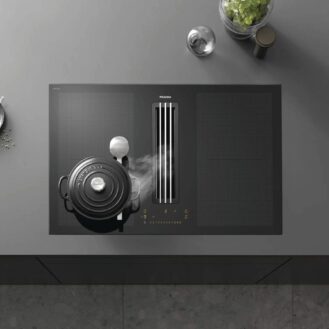
FALMEC Downdraft Extractor
The type of range hood you choose will depend on the layout of your kitchen and your personal preferences. The different types of range hoods include wall-mounted, ceiling-mounted, island, and countertop.
Wall-mounted range hoods are the most common and can be fixed directly to the wall or built into a kitchen cabinet located above the stovetop. Some built-in range hoods have a retractable design to optimize extraction during cooking.
Ceiling-mounted range hoods are either designed to be secured to the ceiling or integrated directly into it, offering a more minimalist appearance. They tend to be more difficult to install than wall-mounted kitchen hoods. Island range hoods are suspended from the ceiling and designed to go directly over a kitchen island. It is important to make sure that they are installed at the right height.
Downdraft extractors, also known as countertop extractors, extract the fumes downwards. They are usually built into the countertop either beside or behind the stove. Many designs are minimalist and retractable. Downdraft extractors are ideal if you want to free up wall space or avoid overhead installations. However, they tend to be less effective than overhead installations because more power is required to extract the fumes downwards.









